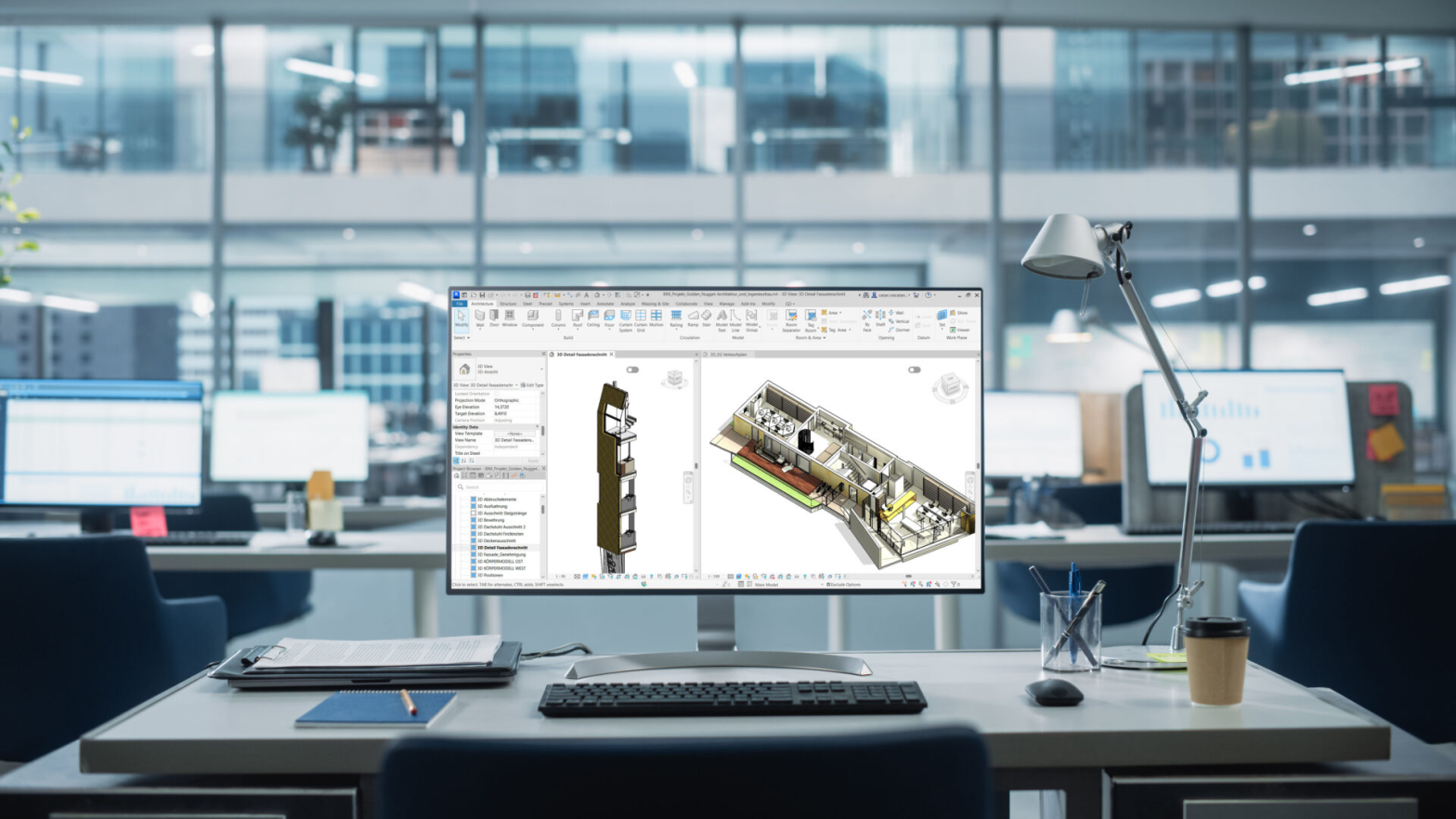
Each year, Autodesk rolls out updates to Revit that push the boundaries of what’s possible in building design and documentation. Revit 2026 is no exception—this release delivers significant enhancements across Architecture, Structure, and MEP disciplines, making collaboration smoother, workflows smarter, and models more accurate. Whether you’re designing facades, detailing HVAC layouts, or coordinating complex multidisciplinary projects, there’s something in Revit 2026 for you.
Here’s a look at what’s new in Revit 2026, from architecture to MEP.
1. Architectural Enhancements: More Control, Better Visualization
Revit 2026 introduces improved flexibility and control for architects, helping streamline conceptual design through to documentation.
- Parametric Assemblies for Facades: A standout feature in 2026 is the enhanced curtain wall system. Designers can now use parametric assemblies for complex façade elements, making it easier to model and adjust intricate designs like perforated screens, patterned panels, and custom mullions with fewer workarounds.
- Site Design Tools: The site tools see another round of improvements, with better grading algorithms and integration with Civil 3D surfaces. Architects can now generate more accurate topographies and instantly visualize cut and fill calculations directly in Revit.
- Material Realism: Autodesk has continued its work on visualization, adding support for improved material realism in both native views and exported files. The updated material library includes more PBR materials, allowing architects to present convincing renders without relying on external rendering software.
2. Structural Improvements: Smarter Analysis and Detailing
Structural engineers and detailers will benefit from greater automation and coordination features in Revit 2026.
- Enhanced Analytical Model Coordination: Structural analytical models are now more tightly integrated with physical models, reducing the time required to maintain consistency. Updates to one will automatically flag corresponding updates in the other, improving coordination between design and analysis.
- Steel Detailing Tools: Revit 2026 adds better rebar detailing options for complex geometries, particularly for curved and sloped elements. New placement patterns, tagging options, and rebar set visualisation make it easier to create shop drawings directly in Revit.
- Load Takedown Tools: A highly requested feature, load takedown tools now allow engineers to trace and document load paths through the structure more effectively, improving early-stage planning and review.
3. MEP Design: Smoother Coordination, Faster Layouts
For MEP professionals, Revit 2026 brings tools aimed at improving layout efficiency, equipment scheduling, and clash avoidance.
- Improved Routing for Ducts and Pipes: Routing logic has been upgraded to be more intuitive, with auto-adjustments around tight corners, smarter elevation transitions, and less manual editing. System classification is more responsive, helping keep ductwork and pipework cleaner and more accurate.
- Smart Equipment Placement: Revit now supports smarter placement rules for mechanical equipment, including clearance zones, connection point snapping, and space validation. This reduces clashes and helps ensure regulatory compliance during layout.
- MEP Fabrication Enhancements: For teams moving toward fabrication-level detail, Revit 2026 adds better integration with Autodesk Fabrication tools, improving workflows between design and shop drawings. Schedules now support nested parameters more easily, improving equipment documentation and coordination.
4. Collaboration and Automation: Powering Integrated Workflows
Across all disciplines, Autodesk continues to invest in better collaboration and automation.
- Cloud Collaboration: The cloud-based Revit collaboration platform is now faster, with quicker sync times and better model performance over slower connections. Revit 2026 also adds support for model-centric issue tracking, making it easier to manage design comments directly within the model environment.
- AI-Driven Design Suggestions: In early stages of implementation, AI-powered suggestions have started appearing in Revit 2026. These include layout optimizations based on design intent and even code compliance suggestions for fire escape paths and mechanical zoning.
- Dynamo 3.0: With Dynamo upgraded to 3.0, visual programming is more stable and intuitive. The new version includes prebuilt scripts for common tasks across architecture, MEP, and structural workflows—ideal for teams looking to automate without deep coding experience.
Final Thoughts
Revit 2026 shows Autodesk’s continued commitment to improving design integration across the building lifecycle. With stronger analytical tools, smarter modelling capabilities, and improved collaboration features, the 2026 release is a valuable upgrade for professionals across Architecture, Structure, and MEP. Whether you’re optimizing designs, streamlining documentation, or pushing the boundaries of BIM, Revit 2026 offers the tools to help you do it better and faster
Testimonials
Very professional and efficient organization. Delivered a great product to a tight deadline.
ACE Power
Karl and the team are very professional and have a vast knowledge of BIM coordination.
Dwayne Willaims Babinda Electrics
We had multiple large projects with tight deadlines and needed a company we could trust. The teams delivery, attention to detail and understanding of what is being designed is always executed to a high standard.
Martin O’Donovan Envar Engineers
Draftech offered a flexible and reliable approach to working collaboratively with our team. They met our expectations and quality requirements and also offered up new ideas.
Draftech have proven to be a valuable and trustworthy resource and we will continue to work with Draftech on other projects.
Simon Marsden Umow Lai
Draftech is different from others in the professionalism and features they provide.
The ability to walk through projects in real time online provides invaluable insight into problem areas and helps provide an efficient resolution on the spot without many phone calls, emails and the necessity for us to paw through countless drawings to understand the issues.
Todd Morris Manager - Air mech
Draftech were put forward to FIP Electrical as the solution to Coordinate, Model, carry out clash detection, provide Electrical Services Shop Drawings, as built documentation and completed electrical model.
Simon Thorpe FIP Electrical
In close collaboration Draftech set up all our systems and model deliverables. In this process Draftech have proven to be a valuable resource for us and demonstrated commitment, understanding and professionalism.
David Skelley DJCoalition
Draftech’s attention to detail and proactive nature throughout the project assisted us in identifying issues before becoming evident on site, saving us both time and unexpected costs.
Matt Payne PJM Engineering Services
They delivered very high quality Revit models and associated 2D documentation at key milestones, working to a tight budget and in strict accordance with the Architects’ BIM requirements.
Peter Thomas Geoff Hesford
We found Draftech’s work to be of high standard and the team delivered exactly as agreed, in fact, when we considered the project complete, Draftech put further resources into the project as they were not satisfied.
John Johnson Beca
Engaging Draftech during design gave us the tools to make smart decisions.
Hansen Yuncken Design Manager - Michael Harkins
The drafting service is timely, reliable and fit for purpose for the built environment.
Peter Harvey Harvey Industries
Draftech stands apart from other drafting services that we have previously used in their attention to detail and ability to adapt to the individual client’s requirements.
Doug Holt McCaig Aircon
I can confidently recommend Draftech as a solid and reliable supplier, and experts in their field. I look forward to working with them again in the near future.
Chris Behan Norman Disney & Young
After seeing the benefits Draftech provided us on the Townsville Hospital Redevelopment we have set up a relationship with Draftech and intend to continue to use their BIM knowledge and skills for our future projects.
Brad Lund Energy Power Systems
Draftech has no competition as they are in a class of their own.
John Boyes Babinda Electrics
Draftech Developments Drafting and Design Capabilities, in conjunction with their outstanding level of Client service and support has provided great solutions to our engineering and Drafting Design portions within our Gorgon Barrow Island Project.
Aaron Hazelton Applied Electro Systems Pty Ltd
Draftech set up necessary systems and workflows very quickly, but also setup auditable estimating and weekly cost tracking processes that we utilised, requiring little maintenance.
TOM PURDON MPM GROUP




























